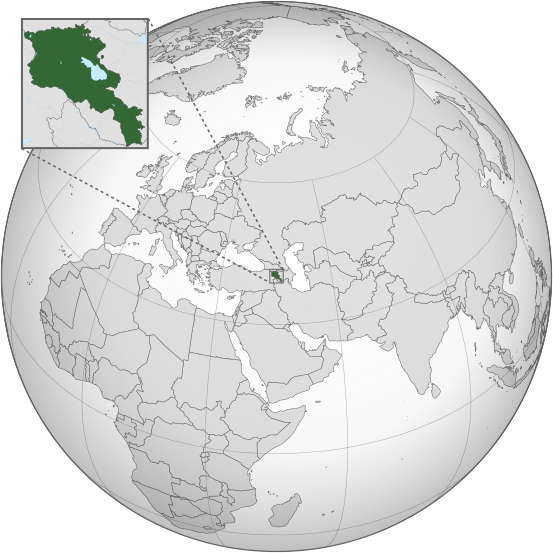By Marco Valerio Solia
In the rich and afflicted Armenian history, periods of splendor and tragic events have alternated cyclically. Situated between two Continents, in a strategic area of the Eurasian mass, Armenia can boast a people of millennial identity, whose past intersects and interacts with the principal cultures of the East and the West.
Despite the great number of events that unites Armenia to Europe (suffice it to think that it was the first country in history to decree Christianity as the State religion), to understand the attraction that this region exercised on Europeans, we must turn our eyes in another direction, towards an element at first sight minor but of highly symbolic value.
In fact, during the Middle Ages, in the courts of kings the skin of a small animal was much appreciated, used for the mantles of monarchs and judges: this minute creature was the ermine, whose name derives from the Latin diminutive “armeninus,” which means, in fact, coming from Armenia. The prestige that surrounded this animal stemmed from its white hair and, especially, from the widespread belief that it preferred to end up as food for its predators rather than seek refuge in damp and dirty burrows that would have compromised its lustre. Hence, this creature became a symbol of dignity and purity, especially preferred to make up the mantles of the highest authorities of European kingdoms.
Such dignity and pride in dramatic moments call to mind the innumerable losses that dot the long Armenian history. In more recent times, the memory runs back to the genocide perpetrated by the Turks during World War I, in which about one and a half million Armenians were exterminated, including women and children. From that moment, every hope of shared memory was vain: still today the Authorities of Ankara deny the genocide and “excommunicate” any country that denounces openly those tragic events.
A strong position was taken in this direction by the Bundestag (the German Parliament) last June 2, when the Lower Chamber recognized the genocide perpetrated by the Ottomans to the harm of the Armenian people, unleashing as a total answer the recalling of the Turkish Ambassador in sign of protest. The Bundestag’s vote seemed courageous if one considers the close relations between Turkey and Germany, especially in the light of the migratory crisis of the last years and the agreements on this subject between Ankara and the European Union. Moreover, the German vote was anticipated in the preceding weeks by Pope Francis’ statements on the “first genocide of the 20th century” that, also in this case, spurred the Turkish government to recall its Ambassador to the Holy See.
However, the difficult relations with Turkey do not represent the only knot to undo for the Erevan government, which finds itself having to address numerous snares, the legacy of a bloody past and of a difficult geographic position.
In this context, the relation with Azerbaijan awakens great concern, especially in regard to the Republic of Nagorno Karabakh, which since the collapse of the Soviet Union is opposed to the Azerbaijani expansionist sights. After a war against Azerbaijan, which ended formally in May of 1994, the tensions between Baku and Erevan have never ceased altogether (proof of it is the new violence that occurred in past months, which caused hundreds of deaths by the parties in dispute, lighting again the spotlights on this forgotten region), accomplice also of the delicate situation of the area, where Armenia is supported by Russia and Azerbaijan by Turkey and the United States.
Inserted in this context is the realization of the gas pipeline that will connect the Azerbaijani gas fields with Europe, passing through Georgia, Turkey, Greece, Albania and arriving finally in Puglia. The three sections of the gas pipeline – the South Caucasus Pipeline, the Trans-Anatolic Pipeline and the Trans-Adriatic Pipeline were projected to diminish European dependence on Russian gas, putting on the markets the gas of Azerbaijani fields in the Caspian Sea. It goes without saying that these imposing infrastructures will in fact avoid Armenia, allied to Moscow and enemy of the Baku government, ousting her from this project.
Moreover, the recent history invites not to be deceived about the stability of the other neighboring countries: it’s difficult to count the number of the crises verified in the last years; suffice it to think of the Russian-Georgian conflict of 2008, of the two Russian wars against rebel Chechnya (1994-1996 the first and 1999-2009 the second), of the Jihadist penetration in Russian Daghestan, not to speak of the dramatic reality of the “Siraq” and, although more distant, of Ukraine: all criticality that increases the chronic instability of the Caucasus powder keg.
Inserted in this difficult picture is Pope Francis’ visit to Armenia, from June 24-26. The Pontiff will find himself grappling with one of the most significant visits of the year, especially in the light of the relation with the Oriental Churches and the tormented Middle East. The hope is that the bases can be laid for an improvement between the countries of the area and the whole of the East.

Armenia and Its Rich and Troubled Past; Pope Francis' Next Stop
The Holy Father arrives in Yerevan on Friday


